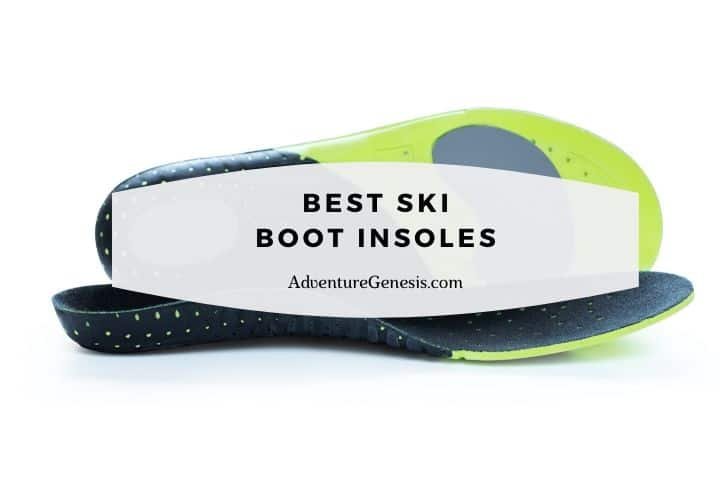One of the least expensive and easiest ways to improve your skiing performance and comfort is by replacing the stock boot insoles with a ski-specific footbed. Your boots play an important role in delivering power and energy to the ski. Ensuring your boots fit correctly is the first step in getting the most out of your equipment, but choosing a good quality insole helps to improve the physical contact and biomechanics of your feet inside the boot.
But which ski boot insoles are best in providing support, cushion, and warmth? The Sidas Winter 3Feet insoles are specifically made for skiing and winter sports, providing the best solution for replacing the stock footbeds. With an integrated aluminum film on the forefoot and gel foam for cushioning, the Sidas Winter 3Feet insoles are a great choice to keep your feet warmer and more comfortable this winter.
By improving contact underfoot, a good ski boot insole will better support and cushion your feet and arch, minimize buckle pressure, and help to keep your feet warm. In the end, all these benefits help you ski better and longer and, thus, maximize your days on the slopes!
Keep reading to learn more about my other top picks.
Last update on 2024-07-22 / Affiliate links / Images from Amazon Product Advertising API
Reviews of the Best Ski Boot Insoles
1. Sidas Winter 3Feet Insoles
The Sidas Winter 3Feet are one of the few insoles developed specifically for winter sports activities. They feature an integrated aluminum film that helps insulate the footbed and works to keep your feet warmer in the coldest temperatures.
In addition, the gel foam cushioning provides both support and padding to help with controlling the ski while keeping your feet from tiring out. Having switched out my standard insoles for the Sidas Winter 3Feet, I have found I have more edge-to-edge quickness with less boot “tightness”. Thus, my feet stay “fresher”, and I am able to ski longer.
Sidas Winter 3Feet come in three levels of arch support: low, mid, and high. They also come in a variety of preformed sizes to match your ski boots’ dimensions.
Pros:
- Made specifically for winter sports
- The aluminum film helps insulate the feet
- Gel foam cushioning provides good support and padding
Cons:
- Some users would still like the insoles to provide more insulation
2. Sole Active Thick EVA Footbed
One of the main advantages of the Sole Active Thick Footbeds is its ability to be heat molded to your specific foot shape. Additionally, Sole insoles are accepted by the American Podiatric Medical Association for their quality materials and features.
The Active Thick EVA Footbeds are a semi-rigid insole with 3.2 mm of Softec cushioning and support. Combined with a zero-drop heel for natural foot alignment and a polygiene coating for active odor-control using recycled silver salt, this is a fantastic insole for active sports, including skiing.
Pros:
- Heat moldable for a custom fit
- Zero-drop heel for natural foot alignment
Cons:
- Some users find the heat molding to be difficult or faulty
3. Superfeet REDhot Insoles
Another insole made specifically for winter sports and skiing, Superfeet REDhot Insoles are a good choice as a footbed replacement due to their ability to keep your feet warm.
While the closed-cell foam’s primary responsibility is to cushion and support your feet, it also acts as an excellent insulator.
The insoles also feature an “Outlast Adaptive Comfort” treatment and a foil forefoot liner to store and release warmth. Thus, the Superfeet REDhot Insoles are the most insulating and warm insoles on this list, which is a great advantage if you ski in very cold temperatures.
The insoles also have some great stabilizing features such as a deep heel cup to keep your foot positioned correctly and a biomechanical shape that reduces stress on the feet and ankles.
Pros:
- These insoles help keep feet warm with a cover treatment, closed-cell foam, and a forefoot foil liner
- Strong stabilizing features
Cons:
- Some users complain of too much heel lift
- Foil liner wears down quickly
4. Tread Labs Stride Insoles
Although not made specifically for skiing or winter activities, the Tread Labs Stride Insoles are recommended by the manufacturer for skiing or boarding.
The insoles feature four arch heights to ensure good coverage and support for a variety of foot types. Also, Tread Labs have some unique removable and replaceable top covers that allow the user to keep their insoles for life with a guarantee to match. With 4 mm of polyurethane foam, the footbeds provide great support and cushioning for days on the slopes.
Pros:
- Four arch heights provide a nearly customizable fit
- Replaceable top covers and a lifetime guarantee
Cons:
- No heat retention features
Why Insoles and Footbeds Improve Your Skiing
A good ski boot insole will improve how you ski in a number of ways. By improving the fit of your boot, you will be more comfortable for longer periods of time on the ski hill. In providing a more custom footbed that fits the contours of your feet and provides more contact and support, you will have better energy transfer from your legs through your feet and to the ski.
Related article: Best Snowboard Boot Insoles
Better Boot Fit
Replacing your original ski boot insoles with any of the above customizable insoles will make your feet fit better in the boot.
The insoles that come with your boots are made to fit all feet, which means people with higher arches will not be receiving the support they need. Thus, when you put pressure on your feet, particularly the inside of the foot on a turn, the arch flattens out, and your feet spread out into the boot.
This may lead to toes hitting the front of the boot, or a feeling that your foot is unstable, and many people try to correct this by over-tightening their boots. Both issues create a boot that is less comfortable to wear for long periods of time.
A good footbed that matches your needed arch support will keep your foot stable inside the boot and allow you to tighten your boot to a comfortable level.
Improved Performance
Arch support provided by aftermarket insoles has the added benefit of putting more distributed pressure on the inside edge of the ski. Because a store-bought insole will provide both more coverage and support than the stock insoles, you get more energy transfer from your legs and feet to the ski.
With more energy transfer, your skiing is not only more powerful but also more economical. A powerful but economical skier is less fatigued and able to ski better for longer periods of time.
My Choice for the Best Ski Boot Insoles
Once again, the Sidas Winter 3Feet remain my top choice for the best ski boot insoles. The three levels of arch support meet the needs of most skiers, and the gel foam cushioning is a good balance between support and padding.
The fact that these insoles also help to keep your feet warm with the aluminum insulation is an added bonus that makes these some of the most popular aftermarket footbeds for skiers and other winter sports enthusiasts.
Top Rated Ski Boot Footbeds
Last update on 2024-07-17 / Affiliate links / Images from Amazon Product Advertising API











